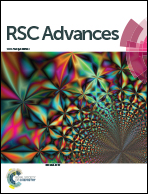Enhanced CO catalytic oxidation of flower-like Co3O4 composed of small nanoparticles
Abstract
Three dimensional (3D) flower-like Co3O4 composed of nanoparticles (NPs) is synthesized via a hydrothermal route to prepare a precursor and a subsequent calcination process to create the Co3O4 phase. Calcination is the key process for controlling the size of the Co3O4 NPs and their catalytic performance. The size of NPs in flower-like samples depends strongly on the heating rate and calcination temperature. High temperatures result in the formation of heterogeneous and large particles. In contrast, the NPs in resulting samples pack together or aggregate, and their sizes decrease with an increasing heating rate. Our CO catalytic oxidation investigation indicates that the flower-like Co3O4 calcined at 400 °C with a heating rate of 1 °C min−1 exhibits the highest catalytic performance with a 100% conversion ratio at 93 °C. This activity originates from the redistribution of ions on the surface of flower-like Co3O4 induced by the calcination process, which generates more Co3+ active sites and active oxygen species adsorbed on the surface of the catalyst. The content of inactive Co2+ cations is reduced simultaneously. It is suggested that the enhanced catalytic activity is due to the increasing number of Co3+ active sites and adsorbed active oxygen species at the surface of flower-like Co3O4 that was calcined under optimum conditions. Meanwhile, the increasing specific surface area also provides more reaction sites for CO catalytic oxidation.


 Please wait while we load your content...
Please wait while we load your content...